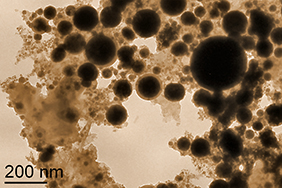Magnetic nanoparticles for diagnostic applications
Develops rapid and simple diagnostic methods based on the use of magnetic nanoparticles for the detection of pathogenic viruses and bacteria.
Magnetic nanoparticles for diagnostic applications
The purpose of this project is to bring forward rapid, low-cost and easy-to-use molecular diagnostic methods based on magnetic nanoparticles for detection of pathogenic viruses and bacteria. The methods are based on magnetic detection of changes in the motion (Brownian relaxation) of suspended functionalized magnetic nanoparticles when they interact with DNA molecules from pathogens. The method also involves different DNA amplification techniques of the probe-target DNA complex. These diagnostic tools can serve as efficient analytical platforms for use at local health centers or at home, allowing for simple individual healthcare solutions as well as more advanced clinical analysis.

Illustration of magnetic nanoparticles.
Responsible researchers:
Teresa Zardán Gómez de la Torre and Darío Sánchez Martín
